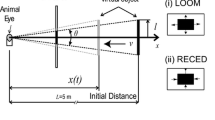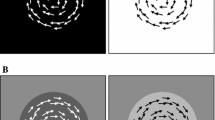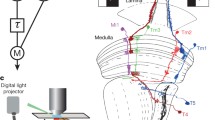Summary
-
1.
Responses to moving contrast gratings and to flicker have been studied in cells in the medulla of the fleshfly Sarcophaga bullata using intracellular recordings and stainings. Medullary neurons responded periodically to flicker. Those which primarily discriminated motion had periodic responses or DC shifts in membrane potentials or increased noise. Intrinsic neurons included a T1a cell which was directionally selective (DS) and specific non-DS amacrine cells (6 types) arborizing either distal or proximal to the serpentine layer. Among the 12 types of output neurons recorded, 1 projected to the lobula plate, 6 to the lobula (Tm and T2 cells), 3 to both the lobula and lobula plate (Y cells), and 2 to the central brain.
-
2.
Irrespective of their projection, medulla neurons which arborize in the stratum of the L2 terminals respond to flicker as does L2 and have the simplest, primarily periodic, responses to motion. The responses have significant power at the second harmonic of the stimulus temporal frequency suggesting that a non-linear operation, such as multiplication, may occur in the L2 stratum. Cells with arbors coinciding with either of the two levels of L1 terminals have much more complex responses to motion. All cells projecting to the lobula plate responded periodically to movement in some direction(s).
Similar content being viewed by others
Abbreviations
- DS:
-
directionally selective
- LMC:
-
lamina monopolar cell
- EMD:
-
elementary motion detector
References
Borst A, Egelhaaf M (1989) Principles of visual motion detection. TINS 12:297–306
Buchner E (1976) Elementary movement detectors in an insect visual system. Biol Cybern 24:85–101
Buchner E, Buchner S, Bülthoff I (1984) Deoxyglucose mapping of nervous activity induced in Drosophila brain by visual movement. I. Wildtype. J Comp Physiol A 155:471–483
Bülthoff I (1986) Deoxyglucose mapping of nervous activity induced in Drosophila brain by visual movement. III. Outer rhabdomeres absent JK84, small optic lobes KS58 and no object fixation E B12, visual mutants. J Comp Physiol A 158:195–202
Bülthoff I, Buchner E (1985) Deoxyglucose mapping of nervous activity induced in Drosophila brain by visual movement. II. Optomotor blind H31 and lobula plate-less N684, visual mutants. J Comp Physiol A 156:25–34
Campos-Ortega JA, Strausfeld NJ (1972) Columns and layers in the second synaptic region of the fly's visual system: the case for two superimposed neuronal architectures. In: Wehner R (ed) Information processing in the visual systems of arthropods. Springer, Berlin Heidelberg New York, pp 31–36
Campos-Ortega JA, Strausfeld NJ (1973) Synaptic connections of intrinsic cells and basket arborizations in the external plexiform layer of the fly's eye. Brain Res 59:119–136
Coombe P, Srinivasan MV, Guy RG (1989) Are the large monopolar cells of the insect lamina on the optomotor pathway? J Comp Physiol A 166:23–35
Detwiler PB, Sarthy PV (1981) Selective uptake of Lucifer Yellow by bipolar cells in the turtle retina. Neurosci Lett 22:227–232
DeVoe RD (1980) Movement sensitivities of cells in the fly's medulla. J Comp Physiol 138:93–119
DeVoe RD (1985) The eye: electrical activity. In: Kerkut G, Gilbert L (eds) Nervous system: Sensory. Pergamon Press, Oxford, pp 227–354
DeVoe RD, Ockleford EM (1976) Intracellular responses from cells of the medulla of the fly, Calliphora erythrocephala. Biol Cybern 23:13–24
DeVoe R, Carras PL, Criswell MH, Guy RG (1989) Not by ganglion cells alone: directional selectivity is widespread in identified cells of the turtle retina. In: Weiler R, Osborne N (eds) The neurobiology of the inner retina. Springer, Berlin Heidelberg New York, pp 235–246
Dubs A (1982) The spatial integration of signals in the retina and lamina of the fly compound eye under different conditions of luminance. J Comp Physiol 146:321–343
Dubs A, Laughlin S, Srinivasan M (1981) Single photon signals in the fly photoreceptors and first order interneurons at behavioral threshold. J Physiol 317:317–334
Egelhaaf M, Borst A (1989) Transient and steady-state response properties of movement detectors. J Opt Soc Am A 6:116–127
Egelhaaf M, Borst A, Reichardt W (1989) Computational structure of a biological motion detection system as revealed by local detector analysis in the fly's nervous system. J Opt Soc Am A 6:1070–1087
Egelhaaf M, Borst A, Pilz B (1990) The role of GABA in detecting visual motion. Brain Res 509:156–160
Fischbach KF, Dittrich APM (1989) The optic lobe of Drosophila melanogaster. I. A Golgi analysis of wild-type structure. Cell Tissue Res 258:441–475
Franceschini N (1975) Sampling of the visual environment by the compound eye of the fly: fundamentals and applications. In: Snyder AW, Menzel R (eds) Photoreceptor optics. Springer, Berlin Heidelberg New York, pp 98–125
Franceschini N (1985) Early processing of colour and motion in a mosaic visual system. Neurosci Res Suppl 2:S17-S49
Franceschini N, Riehle A, Le Nestour A (1986) Properties of the integrated circuit mediating directional selectivity in a movement sensitive neuron. Abstr Soc Neurosci Suppl 12:859
Franceschini N, Riehle A, Le Nestour A (1989) Directionally selective motion detection by insect neurons. In: Stavenga D, Hardie R (eds) Facets of vision. Springer, Berlin Heidelberg New York, pp 360–390
French A, Järvilehto M (1978) The transmission of information by first and second order neurons in the fly visual system. J Comp Physiol 126:87–96
Gilbert C (1990) Membrane conductance changes associated with the response of motion sensitive insect visual neurons. Z Naturforsch 45C:1222–1224
Gilbert C, Penisten D, DeVoe RD (1989) Motion sensitivity in the fly optic lobes: Quantitative comparisons of medullary outputs and presumptive lobula plate inputs. Invest Ophthalmol Visual Sci 30 (Suppl):300
Hardie RC (1985) Functional organization of the fly retina. In: Ottoson D (ed) Progress in Sensory Physiology, vol. 5. Springer, Berlin Heidelberg New York, pp 1–81
Hartley HO (1949) Tests of significance in harmonic analysis. Biometrika 36:194–201
Hausen K (1982) Motion sensitive interneurons in the optomotor system of the fly. II. The horizontal cells: receptive field organization and response characteristics. Biol Cybern 46:67–79
Hausen K (1984) The lobula-complex of the fly: structure function and significance in visual behavior. In: Ali MA (ed) Photoreception and vision in invertebrates. Plenum Press, New York, pp 523–559
Hausen K, Wolburg-Buchholz K, Ribi W (190) The synaptic organization of visual interneurons in the lobula complex of flies. Cell Tissue Res 208:371–387
Järvilehto M, Zeltler F (1973) Electrophysiological-histological studies on some functional properties of visual cells and second order neurons of an insect retina. Z Zellforsch 136:291–306
Kelly KM, Mote MI (1990) Electrophysiology and anatomy of medulla interneurons in the optic lobe of the cockroach Periplaneta americana. J Comp Physiol A 167:745–756
Kirschfeld K (1972) The visual system of Musca: studies on optics, structure and function. In: Wehner R (ed) Information processing in the visual systems of arthropods. Springer, Berlin Heidelberg New York, pp 61–75
Land M, Eckert H (1985) Maps of the acute zones of fly eye. J Comp Physiol A 156:525–538
Laughlin S (1984) The roles of parallel channels in early visual processing by the arthropod compound eye. In: Ali MA (ed) Photoreception and vision in invertebrates. Plenum Press, New York, pp 457–481
Laughlin S, Osorio D (1989) Mechanism for neural signal enhancement in the blowfly compound eye. J Exp Biol 144:113–146
Lee J-K, Strausfeld N (1989) In flies, motion-sensitive neurons are postsynaptic to multiple representations of single visual sampling points: anatomical evidence for elemental motion detectors. Soc Neurosci Abstr 15:1291
Mimura K (1971) Movement discrimination by the visual system of flies. Z Vergl Physiol 73:105–138
Mimura K (1972) Neural mechanisms subserving directional selectivity of movement in the optic lobe of the fly. J Comp Physiol 80:409–437
Osorio D (1986) Directionally selective cells in the locust medulla. J Comp Physiol A 159:841–847
Palka J, Pinter RB (1975) Theoretical and experimental analysis of visual acuity in insects. In: Horridge GA (ed) The compound eye and vision of insects. Oxford University Press, London, pp 321–337
Penisten DK (1988) Visual motion sensitivity in the fly medulla. Phd Dissertation, Indiana University, Bloomington, IN
Riehle A, Franceschini N (1982) Response of a direction-selective, movement detecting neuron under precise stimulation of two identified photoreceptor cells. Neurosci Lett (Suppl 10):S411–S412
Riehle A, Franceschini N (1984) Motion detection in flies: parametric control over on-off pathways. Exp Brain Res 54:390–394
Sarthy PV, Hilbush BS (1983) Lucifer Yellow uptake in developing rat retina: selective staining of horizontal cells. Dev Brain Res 11:275–280
Shaw S (1981) Anatomy and physiology of non-spiking cells in the photoreceptor-lamina complex of the compound eye of insects, especially Diptera. In: Roberts A, Bush BMH (eds) Neurons without impulses. Cambridge University Press, Cambridge, pp 61–116
Shaw S (1984) Early visual processing in insects. J Exp Biol 112:225–251
Shaw S (1989) The retina-lamina pathway in insects, particularly Diptera, viewed from an evolutionary perspective. In: Stavenga D, Hardie R (eds) Facets of vision. Springer, Berlin Heidelberg New York, pp 186–212
Spurr A (1969) A low-viscosity epoxy resin embedding medium for electron microscopy. J Ultrastruct Res 26:31–43
Srinivasan MV, Pinter RB, Osorio D (1990) Matched filtering in the visual system of the fly: Large monopolar cells of the lamina are optimized to detect moving edges and blobs. Proc R Soc Lond B 240:279–293
Stewart WW (1978) Functional connections between cells as revealed by dye-coupling with a highly fluorescent naphthalimide tracer. Cell 14:741–759
Strausfeld NJ (1970) Golgi studies on insects, Part II. The optic lobes of Diptera. Philos Trans R Soc Lond (Biol) 258:135–223
Strausfeld NJ (1976) Atlas of an insect brain. Springer, Berlin Heidelberg New York
Strausfeld NJ (1984) Functional neuroanatomy of the blowfly's visual system. In: Ali MA (ed) Photoreception and vision in invertebrates. Plenum Press, New York, pp 483–522
Strausfeld NJ, Bassemir UK (1983) Cobalt-coupled neurons of a giant fibre system in Diptera. J Neurocytol 12:971–991
Strausfeld NJ, Nässel DR (1981) Neuroarchitecture of brain regions that subserve the compound eyes of Crustacea and insects. In: Autrum H (ed) (Handbook of sensory physiology, vol. VII/6B) Springer, Berlin Heidelberg New York, pp 1–132
Thibos L, Walsh DJ, Cheney FE (1987) Vision beyond the resolution limit: aliasing in the periphery. Vision Res 27:2193–2197
Wehrhahn C (1985) Visual guidance of flies during flight. In: Kerkut GA, Gilbert LI (eds) Comparative insect physiology, biochemistry and pharmacology 6:673–684
Wilcox M, Franceschini N (1984) Illumination induces dye incorporation in photoreceptor cells. Science 225:851–854
Zettler F, Järvilehto M (1972) Lateral inhibition in an insect eye. Z Vergl Physiol 76:233–244
Author information
Authors and Affiliations
Rights and permissions
About this article
Cite this article
Gilbert, C., Penisten, D.K. & DeVoe, R.D. Discrimination of visual motion from flicker by identified neurons in the medulla of the fleshfly Sarcophaga bullata . J Comp Physiol A 168, 653–673 (1991). https://doi.org/10.1007/BF00224356
Accepted:
Issue Date:
DOI: https://doi.org/10.1007/BF00224356




